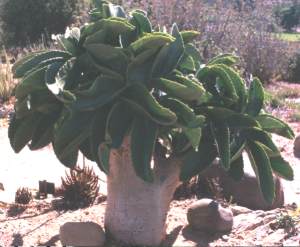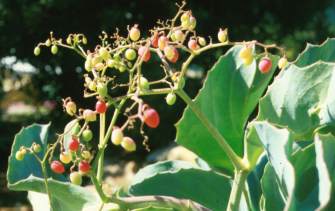Cyphostemma juttae
Cyphostemma juttae (Dinter & Gilg) Desc.
Family: Vitaceae
Common names: wild grape, tree grape, Namibian grape (Eng.); droog-my-keel (Afr.)
Introduction
The tree grape is a slow-growing succulent with a huge swollen trunk (caudiciform).

Description
Description
Due to its distribution, the wild grape has evolved and adapted very well in order to survive. The presence of white, drooping, papery pieces of bark on the yellow-green stems is very typical of this species. In summer, this helps to reflect away the sunlight in order to keep the plant cool. The thick, fleshy stem and leaves act as water reservoirs in times of drought. A fully-grown plant can measure up to 2 m. The leaves are large, shiny, ovate, fleshy and toothed and fall off during the winter months.

Flowers are inconspicuous, but the large grape-like bunches of bright wine-coloured berries appearing near the end of summer make this succulent a true showpiece for container and garden alike.

Distribution and habitat
Distribution description
Cyphostemma juttae occurs in Namibia where it is exposed to very dry and hot conditions.
Growing Cyphostemma juttae
Grow
Cyphostemma juttae is a very sought-after plant for the garden, as are other caudiciform plants such as baobabs, adeniums and tylecodons. They make superb container or open garden subjects in and around the garden, especially around swimming pools and courtyards. Because this species grows mainly in the summer, plants must be kept dry during the colder winter months. They are ideal accent plants for a rockery, or may be planted in a large container on a sunny protected patio.
The tree grape fares best in a loamy or sandy soil where drainage is optimal. Adding plenty of river sand and general compost will greatly improve drainage in heavy clay soils. Soil quality can also be improved dramatically by lightly working some bone meal into the soil. Although smelly, the effect on soils is quite remarkable. As a rule of thumb, use only organic products, such as those based on seaweed extract, especially if plants are going to be fed on a regular basis. Organic products won't burn or damage plants.
As with all succulents, one must be careful not to over-water. These plants can survive with very little water, and too often plants die as a result of excessive water. If one lives in a very wet area, it is preferable to keep plants in large containers where they can be easily moved to a sheltered place. This also helps where severe frost occurs as cyphostemmas are not completely resistant to frost.
The seeds of Cyphostemma juttae can be sown in winter (June to August). Although they take a considerable time to germinate, success is almost guaranteed. Propagation can also be undertaken by means of cuttings. Cuttings or truncheons can be rooted in coarse river sand. Again it is important to water with caution, especially after the cuttings have rooted.
References
- BARKUIZEN, B.P. 1987. Succulents of southern Africa. Purnell, Cape Town.
- JOFFE, P. 1993. The gardeners guide to South African plants. Tafelberg, Cape Town.
Credits
Werner Voigt
Karoo Desert National Botanical Garden
August 2002
Plant Attributes:
Plant Type: Succulent
SA Distribution:
Soil type: Sandy, Clay, Loam
Flowering season: Spring, Early Summer
PH: Alkaline, Neutral
Flower colour: White
Aspect: Full Sun
Gardening skill: Average, Easy
Special Features:
Horticultural zones










Rate this article
Article well written and informative
Rate this plant
Is this an interesting plant?
Login to add your Comment
Back to topNot registered yet? Click here to register.